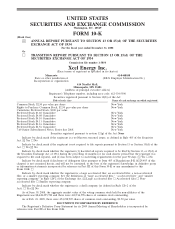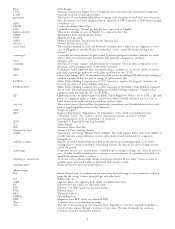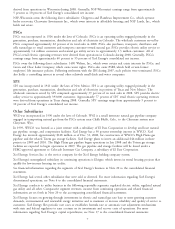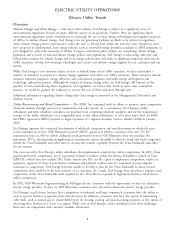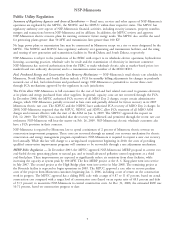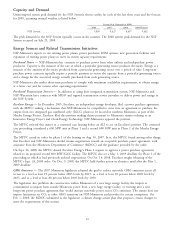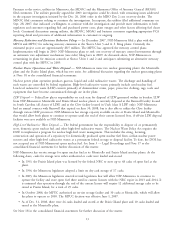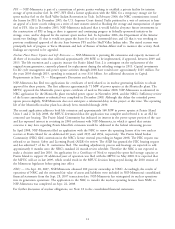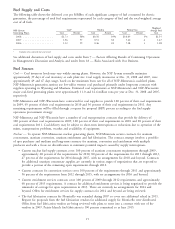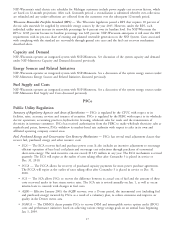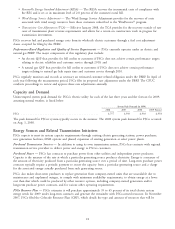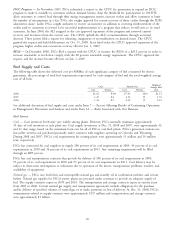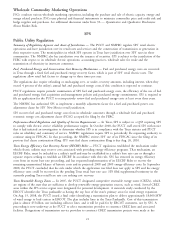Xcel Energy 2008 Annual Report Download - page 21
Download and view the complete annual report
Please find page 21 of the 2008 Xcel Energy annual report below. You can navigate through the pages in the report by either clicking on the pages listed below, or by using the keyword search tool below to find specific information within the annual report.Renewable Energy Standard (RES) — The 2007 Minnesota legislature adopted a RES statute requiring that 30 percent
of NSP-Minnesota’s energy requirements by 2020 come from qualifying renewable sources, primarily wind energy. Costs
associated with complying with the standard are recoverable through automatic recovery mechanisms.
NSP-Minnesota has filed with the MPUC a renewable energy plan for adding wind resources. This plan seeks to
achieve balance in the wind portfolio, with roughly half of new resources being owned by NSP-Minnesota and
achieving roughly proportionate shares between community-based energy developments, other power purchase
agreements and utility projects.
Conservation and DSM Legislation — The 2007 Minnesota legislature adopted a statute establishing a statewide goal
to reduce energy demand by 1.5 percent per year and fossil fuel use by 15 percent. The bill requires utilities to propose
conservation and DSM programs that achieve at least 1.0 percent per year reduction in energy demand, subject to
limitations regarding excessive costs for customers, reliability or other negative consequences. The statute also allows
utilities to fund internal infrastructure changes that will contribute to lower energy use and provides for cost recovery
outside a rate case for such projects.
2008 Minnesota Legislative Session — The 2008 Minnesota legislature considered and adopted several measures related
to energy policy and regulation, including:
• Encouraging Minnesota’s participation in the Midwest Governors’ Association’s GHG accord and commissioning
of an economic study of the potential impacts of a carbon cap-and-trade program;
• Modifying the existing TCR mechanism to allow for recovery of costs associated with MISO charges for regional
transmission expansion;
• Providing for recovery via a rate rider mechanism of certain energy storage projects associated with renewable
energy projects; and
• Providing for a streamlined approval process for wind and solar projects needed to comply with Minnesota’s RES.
The legislature considered, but did not adopt, increased taxes on utility property.
NSP System Resource Plan — In December 2007, NSP-Minnesota filed its 2007 resource plan with the MPUC. The
plan incorporates the actions needed to comply with expansive new legislation regarding GHG emissions control,
renewable energy procurement, and DSM adopted by the 2007 Minnesota legislature. Due to the expansion of wind
generation procurement and DSM obligations, the plan indicates that the type of incremental resources has changed
from prior plans. Key provisions of the plan include the following:
• Adding 2,600 MW of wind generation resources to comply with our RES of 30 percent renewable energy by
2020.
• Increases in DSM of approximately 30 percent energy savings and 50 percent demand savings.
• Seek license renewals for Prairie Island’s two units through 2033 and 2034, respectively, and expand capacity at
Prairie Island by 160 MW and Monticello by 71 MW.
• Request approval to make environmental and capacity upgrades at Sherburne County (Sherco). The
environmental upgrades would result in a significant reduction in overall SO2, NOx and mercury emissions from
the facility.
• Negotiate and seek approval of purchases from Manitoba Hydro Electric Board (Manitoba Hydro) for 375 MW
of intermediate and 350 MW of peaking resources beginning in 2015.
• Incremental peaking and intermediate generation needs of 2,300 MW.
• Carbon emission reductions of 22 percent below 2005 levels by 2020.
In June 2008, intervenors filed comments on this plan. The Minnesota Office of Energy Security (OES) recommended
approval, subject to further expansion of DSM goals. Environmental intervenors recommended expanded DSM goals
and expressed concerns regarding carbon management with the proposed expansion of certain coal resources. Excelsior
Energy recommended inclusion of its proposed project in the plan. The Prairie Island Community expressed health and
safety concerns regarding nuclear resources. The Minnesota Chamber of Commerce expressed interest in cost and rate
management. NSP-Minnesota filed reply comments in September 2008 providing updated information, including a
11


